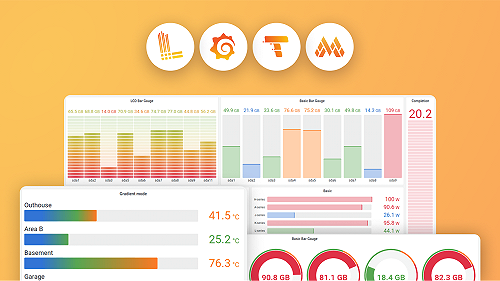Monitor Kubernetes logs with Grafana Alloy
Kubernetes captures logs from each container in a running Pod.
With Alloy, you can collect Kubernetes logs, forward them to a Grafana stack, and create dashboards to monitor your Kubernetes Deployment.
The alloy-scenarios repository contains complete examples of Alloy deployments.
Clone the repository and use the examples to understand how Alloy collects, processes, and exports telemetry signals.
This example scenario uses a Kubernetes Monitoring Helm chart to deploy and monitor Kubernetes logs.
It installs three Helm charts: Loki, Grafana, and Alloy.
The Helm chart simplifies configuration and deploys best practices for monitoring Kubernetes clusters.
Alloy, installed with k8s-monitoring-helm, collects two log sources: Pod Logs and Kubernetes Events.
Before you begin
Ensure you have the following:
Clone and deploy the example
Follow these steps to clone the scenarios repository and deploy the monitoring example:
Clone the Alloy scenarios repository:
git clone https://github.com/grafana/alloy-scenarios.gitSet up the example Kubernetes environment:
Navigate to the
alloy-scenarios/k8s-logsdirectory:cd alloy-scenarios/k8s-logsCreate a local Kubernetes cluster using kind.
Thekind.ymlfile provides the cluster configuration:kind create cluster --config kind.ymlAdd the Grafana Helm repository:
helm repo add grafana https://grafana.github.io/helm-chartsCreate the
metaandprodnamespaces:kubectl create namespace meta && \ kubectl create namespace prod
Deploy Loki in the
metanamespace.
Loki stores the collected logs.
Theloki-values.ymlfile contains the Loki Helm chart configuration:helm install --values loki-values.yml loki grafana/loki -n metaThis Helm chart installs Loki in monolithic mode.
For more details, refer to the Loki documentation.Deploy Grafana in the
metanamespace.
You can use Grafana to visualize the logs stored in Loki.
Thegrafana-values.ymlfile contains the Grafana Helm chart configuration:helm install --values grafana-values.yml grafana grafana/grafana --namespace metaThis Helm chart installs Grafana and sets the
datasources.datasources.yamlfield to the Loki data source configuration.Deploy Alloy in the
metanamespace.
Thek8s-monitoring-values.ymlfile contains the Kubernetes monitoring Helm chart configuration:helm install --values ./k8s-monitoring-values.yml k8s grafana/k8s-monitoring -n meta --create-namespaceThis Helm chart installs Alloy and specifies the Pod logs and Kubernetes Events sources that Alloy collects logs from.
Port-forward the Grafana Pod to your local machine:
Get the name of the Grafana Pod:
export POD_NAME=$(kubectl get pods --namespace meta -l "app.kubernetes.io/name=grafana,app.kubernetes.io/instance=grafana" -o jsonpath="{.items[0].metadata.name}")Set up port-forwarding:
kubectl --namespace meta port-forward $POD_NAME 3000
Port-forward the Alloy Pod to your local machine:
Get the name of the Alloy Pod:
export POD_NAME=$(kubectl get pods --namespace meta -l "app.kubernetes.io/name=alloy-logs,app.kubernetes.io/instance=k8s" -o jsonpath="{.items[0].metadata.name}")Set up port-forwarding:
kubectl --namespace meta port-forward $POD_NAME 12345
Deploy Grafana Tempo to the
prodnamespace.
Tempo generates logs for this example:helm install tempo grafana/tempo-distributed -n prod
Monitor and visualize your data
Use Grafana to monitor your deployment’s health and visualize your data.
Monitor the health of your Alloy deployment
To monitor the health of your Alloy deployment, open your browser and go to http://localhost:12345.
For more information about the Alloy UI, refer to Debug Grafana Alloy.
Visualize your data
To use the Grafana Logs Drilldown, open your browser and go to http://localhost:3000/a/grafana-lokiexplore-app.
To create a dashboard to visualize your metrics and logs, open your browser and go to http://localhost:3000/dashboards.
Understand the Kubernetes Monitoring Helm chart
The Kubernetes Monitoring Helm chart, k8s-monitoring-helm, collects, scrapes, and forwards Kubernetes telemetry data to a Grafana stack.
This includes metrics, logs, traces, and continuous profiling data.
cluster
Define the cluster name as meta-monitoring-tutorial.
This is a static label attached to all logs collected by the Kubernetes Monitoring Helm chart.
cluster:
name: meta-monitoring-tutorialdestinations
Define a destination named loki to forward logs to Loki.
The url attribute specifies the URL of the Loki gateway.
destinations:
- name: loki
type: loki
url: http://loki-gateway.meta.svc.cluster.local/loki/api/v1/pushclusterEvents
Enable the collection of cluster events.
collector: Use thealloy-logscollector to collect logs.namespaces: Specify themetaandprodnamespaces to collect logs from.
clusterEvents:
enabled: true
collector: alloy-logs
namespaces:
- meta
- prodnodeLogs
Disable the collection of node logs.
Collecting node logs requires mounting /var/log/journal, which is out of scope for this example.
nodeLogs:
enabled: falsepodLogs
Enable the collection of Pod logs.
labelsToKeep: Specify labels to keep when collecting logs.
This configuration removespodfrom the labels to keep.structuredMetadata: Specify structured metadata to collect.
This configuration sets the structured metadatapodto keep the Pod name for querying.
podLogs:
enabled: true
gatherMethod: kubernetesApi
collector: alloy-logs
labelsToKeep: ["app_kubernetes_io_name","container","instance","job","level","namespace","service_name","service_namespace","deployment_environment","deployment_environment_name"]
structuredMetadata:
pod: pod # Set structured metadata "pod" from label "pod"
namespaces:
- meta
- prodDefine the Alloy role
The Kubernetes Monitoring Helm chart deploys only what you need.
In this case, the configuration deploys Alloy with the capability to collect logs.
Metrics, traces, and continuous profiling are disabled.
alloy-singleton:
enabled: false
alloy-metrics:
enabled: false
alloy-logs:
enabled: true
alloy:
mounts:
varlog: false
clustering:
enabled: true
alloy-profiles:
enabled: false
alloy-receiver:
enabled: false


